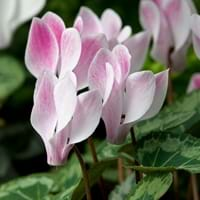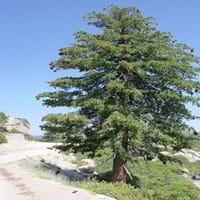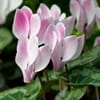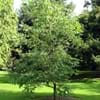Life Span
Perennial
Perennial
Type
Flowering Plants, Tubers
Needled or Scaled Evergreen
Origin
Europe, Mediterranean Basin, Middle East, North Africa, Somalia
Western United States, Canada
Types
Cyclamen Africanum, Cyclamen Alpinum, Cyclamen Cilicium, Cyclamen Coum
Not Available
Number of Varieties
Not Available
Habitat
Alpine Meadows, Rocky areas, Woods
Woodland Garden Canopy
USDA Hardiness Zone
5-9
Not Available
Sunset Zone
15, 16, 17, 18, 19, 20, 21, 22, 23, 24
Not Available
Habit
Clump-Forming
Oval or Rounded
Flower Color
Pink, Purple, White
Non Flowering Plant
Flower Color Modifier
Not Available
Bicolor
Fruit Color
Brown
Brown, Sandy Brown
Leaf Color in Spring
Several shades of Green
Not Available
Leaf Color in Summer
Not Available
Not Available
Leaf Color in Fall
Green, Silver
Not Available
Leaf Color in Winter
Green, Silver
Not Available
Leaf Shape
Heart-shaped
Needle like
Plant Season
Autumn, Spring, Summer, Winter
Spring, Summer, Fall, Winter
Sunlight
Indirect sunlight
Full Sun
Growth Rate
Medium
Medium
Type of Soil
Clay, Sandy, Well drained
Loam
The pH of Soil
Acidic
Acidic, Neutral
Soil Drainage
Well drained
Well drained
Bloom Time
Autumn, Spring, Summer
Not Available
Tolerances
Not Available
Drought
Where to Plant?
Container, Ground, Pot
Ground
How to Plant?
From bulbs, Seedlings
Cuttings, Seedlings
Plant Maintenance
Medium
Medium
Watering Requirements
Do not water frequently, It cannot sustain wet-feet, Keep the ground moist but not water-logged, Prefer drip-irrigation instead of Over-head watering, Water when soil is dry
Water three times weekly in summer
In Summer
Lots of watering
Lots of watering
In Spring
Moderate
Moderate
In Winter
Average Water
Average Water
Soil pH
Acidic
Acidic, Neutral
Soil Type
Clay, Sandy, Well drained
Loam
Soil Drainage Capacity
Well drained
Well drained
Sun Exposure
Indirect sunlight
Full Sun
Pruning
Cut or pinch the stems, Prune if you want to improve plant shape, Prune ocassionally, Prune to control growth, Prune when plant is dormant, Remove dead leaves, Remove dead or diseased plant parts
Remove damaged leaves, Remove dead branches, Remove dead leaves
Fertilizers
All-Purpose Liquid Fertilizer
27-3-3 ratio, Requires high amount of nitrogen
Pests and Diseases
Aphids, Botrytis Cinerea, Gray mold, Mice, Mites, Root weevil, Slugs, Snails, Squirrels
Blister Rust
Plant Tolerance
Drought
Drought
Flower Petal Number
Single
Single
Foliage Texture
Medium
Not Available
Foliage Sheen
Matte
Glossy
Attracts
Not Available
Douglas squirrels, Owls
Allergy
Respiratory problems
Skin irritation
Aesthetic Uses
Showy Purposes
Not Used For Aesthetic Purpose
Beauty Benefits
Not Available
Not Available
Environmental Uses
Air purification
Air purification
Medicinal Uses
Digestive disorders, Menstrual Disorders
Carminative, Laxative, Opthalmic, Poultice
Part of Plant Used
Root, Stem
Seeds, Wood
Other Uses
Showy Purposes, Used as an ointment
Adhesive, Used as a chewing gum, Used for making green dye, Vanillin flavouring is obtained as a by-product
Used As Indoor Plant
Yes
No
Used As Outdoor Plant
Yes
Yes
Garden Design
Not Available
Feature Plant
Botanical Name
Cyclamen Persicum
PINUS lambertiana
Common Name
Cyclamen or Florist's Cyclamen
Sugar pine, Sugar cone pine
In Hindi
Sikalemen
Sugar Pine
In German
Zyklamen
Sugar Pine
In French
Cyclamen
Sugar Pine
In Spanish
Ciclamen
Sugar Pine
In Greek
κυκλάμινο
Sugar Pine
In Portuguese
Cíclame
Sugar Pine
In Polish
Cyklamen
Sugar Pine
In Latin
Cyclamīnos
Pinus
Phylum
Anthophyta
Coniferophyta
Class
Dicotyledonae
Pinopsida
Family
Primulaceae
Pinaceae
Clade
Not Available
Not Available
Tribe
Cyclamineae
Not Available
Subfamily
Myrsinoideae
Pinoideae
Number of Species
Not Available
Season and Care of Cyclamen and Sugar Pine
Season and care of Cyclamen and Sugar Pine is important to know. While considering everything about Cyclamen and Sugar Pine Care, growing season is an essential factor. Cyclamen season is Autumn, Spring, Summer and Winter and Sugar Pine season is Autumn, Spring, Summer and Winter. The type of soil for Cyclamen is Clay, Sandy, Well drained and for Sugar Pine is Loam while the PH of soil for Cyclamen is Acidic and for Sugar Pine is Acidic, Neutral.
Cyclamen and Sugar Pine Physical Information
Cyclamen and Sugar Pine physical information is very important for comparison. Cyclamen height is 0.54 cm and width 0.75 cm whereas Sugar Pine height is 1,520.00 cm and width 760.00 cm. The color specification of Cyclamen and Sugar Pine are as follows:
Cyclamen flower color: Pink, Purple and White
Cyclamen leaf color: Several shades of Green
Sugar Pine flower color: Non Flowering Plant
- Sugar Pine leaf color: Not Available
Care of Cyclamen and Sugar Pine
Care of Cyclamen and Sugar Pine include pruning, fertilizers, watering etc. Cyclamen pruning is done Cut or pinch the stems, Prune if you want to improve plant shape, Prune ocassionally, Prune to control growth, Prune when plant is dormant, Remove dead leaves and Remove dead or diseased plant parts and Sugar Pine pruning is done Remove damaged leaves, Remove dead branches and Remove dead leaves. In summer Cyclamen needs Lots of watering and in winter, it needs Average Water. Whereas, in summer Sugar Pine needs Lots of watering and in winter, it needs Average Water.





